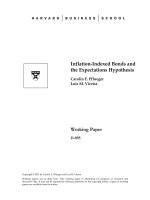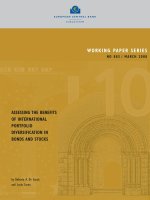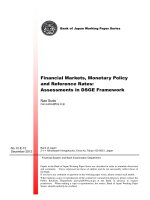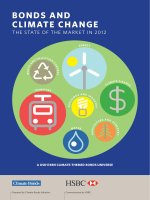Quantitative financial economics stocks bonds and foreign exchage
Bạn đang xem bản rút gọn của tài liệu. Xem và tải ngay bản đầy đủ của tài liệu tại đây (22.72 MB, 493 trang )
I
Quantitative Financial Economics
SERIES IN
FINANCIAL ECONOMICS
AND QUANTITATIVEANALYSIS
Series Editor:
Editorial Board:
Stephen Hall, London Business School, UK
Robert F. Engle, University of California, USA
John Flemming, European Bank, UK
Lawrence R. Klein, University of Pennsylvania, USA
Helmut Liitkepohl, Humboidt University, Germany
The Economics of Pensions and Variable Retirement Schemes
Oliver Fabel
Applied General Equilibrium Modelling:
Imperfect Competition and European Integration
Dirk Willenbockel
Housing, Financial Markets and the Wider Economy
David Miles
Maximum Entropy Econometrics: Robust Estimation with Limited Data
Amos Golan, George Judge and Douglas Miller
Estimating and Interpreting the Yield Curve
Nicola Anderson, Francis Breedon, Mark Deacon,
Andrew D e r v and Gareth Murphy
Further titles in preparation
Proposals will be welcomed by the Series Editor
L Quantitative Financial Economi
Stocks, Bonds and Foreign Exchange
Keith Cuthbertson
Newcastle upon Tyne University
and
City University Business School
Chichester
JOHN WILEY & SONS
New York
Brisbane
Toronto
Singa
International (+44) 1243 779777
e-mail (for orders and customer service enquiries):
Visit our Home Page on
or
Reprinted December 1996, August 1997, September 1999
All Rights Reserved. No part of this book may be reproduced, stored in a retrieval system, o
in any form or by any means, electronic, mechanical, photocopying, recording or otherwise, ex
terms of the Copyright, Designs and Patents Act 1988 or under the terms of a licence issued by
Licensing Agency, 90 Tottenham Court Road, London, U K WIP 9HE, without the permission in
pub1isher.
Other Wiley Editorial Ofices
John Wiley & Sons, Inc., 605 Third Avenue,
New York, NY 10158-0012, USA
Jacaranda Wiley Ltd. 33 Park Road, Milton,
Queensland 4064, Australia
John Wiley & Sons (Canada) Ltd, 22 Worcester Road,
Rexdale, Ontario M9W 1L1, Canada
John Wiley & Sons (Asia) Pte Ltd, 2 Clementi Loop #02-01,
Jin Xing Distripark, Singapore 129809
Library of Congress Caf~ging-in-PublicafionData
Cuthbertson, Keith.
Quantitative financial economics : stocks, bonds, and foreign
exchange / Keith Cuthbertson.
cm. - (Series in financial economics and quantitative
p:
analysis)
Includes bibliographical references and index.
ISBN 0-471-95359-8 (cloth). - ISBN 0-471-95360-1 (pbk.)
1. Investments - Mathematical models. 2. Capital assets pricing
model. 3. Stocks - Mathematical models. 4. Bonds - Mathematical
models. 5 . Foreign exchange - Mathematical models. I. Title.
11. Series.
HG4515.2.C87 1996
95 - 48355
332.6 - dc20
CIP
British Library Cataloguing in Publicafion Data
A catalogue record for this book is available from the British Library
ISBN 0-471-95359-8 (Cased)
0-471-95360-1 (Paperback)
Typeset in 10/12pt Times Roman by Laser Words, India
Printed and bound in Great Britain by Bookcraft (Bath) Ltd, Avon
This book is printed on acid-free paper responsibly manufactured from sustainable
forestation, for which at least two trees are planted for each one used for paper production.
Dedication
To June
I
This page intentionally left blank
Contents
Series Preface
Introduction
Acknowledgements
Part 1 Returns and Valuation
1 Basic Concepts in Finance
1.1 Returns on Stocks, Bonds and Real Assets
1.2 Utility and Indifference Curves
1.3 Physical Investment Decisions and Optimal Consumption
1.4 Summary
Endnotes
2 The Capital Asset Pricing Model: CAPM
2.1 An Overview
2.2 Portfolio Diversification, Efficient Frontier and
the Transformation Line
2.3 Derivation of the CAPM
2.4 Summary
Appendix 2.1 Derivation of the CAPM
3 Modelling Equilibrium Returns
3.1 Extensions of the CAPM
3.2 A Simple Mean-Variance Model of Asset Demands
3.3 Performance Measures
3.4 The Arbitrage Pricing Theory (APT)
3.5 Testing the Single Index Model, the CAPM and the APT
3.6 Summary
4 Valuation Models
4.1 The Rational Valuation Formula (RVF)
4.2 Summary
Endnotes
Further Reading
5.2 Implications of the EMH
5.3 Expectations, Martingales and Fair Game
5.4 Testing the EMH
5.5 Summary
Endnotes
Empirical Evidence on Efficiency in the Stock Market
6.1 Predictability in Stock Returns
6.2 Volatility Tests
6.3 Summary
Endnotes
Appendix 6.1
Rational Bubbles
7.1 Euler Equation and the Rational Valuation Formula
7.2 Tests of Rational Bubbles
7.3 Intrinsic Bubbles
7.4 Summary
Endnotes
Anomalies, Noise Traders and Chaos
8.1 The EMH and Anomalies
8.2 Noise Traders
8.3 Chaos
8.4 Summary
Appendix 8.1
Appendix 8.2
Endnote
Further Reading
Part 3 The Bond Market
9 Bond Prices and the Term Structure of Interest Rates
9.1 Prices, Yields and the RVF
9.2 Theories of the Term Structure
9.3 Summary
Endnotes
10 Empirical Evidence on the Term Structure
10.1 The Behaviour of Rates of Return
10.2 Pure Discount Bonds
10.3 Coupon Paying Bonds: Bond Prices and the Yield to Maturity
10.4 Summary
Appendix 10.1 Is the Long Rate a Martingale?
Appendix 10.2 Forward Rates
Endnotes
Further Reading
11.2 Purchasing Power Parity (PPP)
11.3 Interrelationships between CIP, UIP and PPP
11.4 Summary
Appendix 11.1 PPP and the Wage-Price Spiral
12 Testing CIP, UIP and FRU
12.1 Covered Interest Arbitrage
12.2 Uncovered Interest Parity and Forward Rate Unbiasedness
12.3 Forward Rate: Risk Aversion and Rational Expectations
12.4 Exchange Rates and News
12.5 Peso Problems and Noise Traders
12.6 Summary
Appendix 12.1 Derivation of Fama’s Decomposition of the Risk Premium
in the Forward Market
13 The Exchange Rate and Fundamentals
13.1 Flex-Price Monetary Model
13.2 Sticky-Price Monetary Model (SPMM)
13.3 Dornbusch Overshooting Model
13.4 Frankel Real Interest Differential Model (RIDM)
13.5 Testing the Models
13.6 Chaos and Fundamentals
13.7 Summary
Further Reading
Part 5 Tests of the EMH using the VAR Methodology
14 The Term Structure and the Bond Market
14.1 Cross-equation Restrictions and Informational Efficiency
14.2 The VAR Approach
14.3 Empirical Evidence
14.4 Summary
Endnotes
15 The FOREX Market
15.1 Efficiency in the FOREX Market
15.2 Recent Empirical Results
15.3 Summary
Endnotes
16 Stock Price Volatility
16.1 Theoretical Issues
16.2 Stock Price Volatility and the VAR Methodology
16.3 Empirical Results
16.4 Persistence and Volatility
Appendix 16.1 Returns, Variance Decomposition and Persistence
17 Risk Premia: The Stock Market
17.1 What Influences Stock Market Volatility?
17.2 The Impact of Risk on Stock Returns
17.3 Summary
18 The Mean-Variance Model and the CAPM
18.1 The Mean-Variance Model
18.2 Tests of the CAPM Using Asset Shares
18.3 Summary
19 Risk Premia and the Bond Market
19.1 Time Varying Risk: Pure Discount Bonds
19.2 Time Varying Risk: Long-Term Bonds
19.3 Interaction Between Stock and Bond Markets
19.4 Summary
Endnotes
Further Reading
Part 7 Econometric Issues in Testing Asset Pricing Models
20 Economic and Statistical Models
20.1 Univariate Time Series
20.2 Multivariate Time Series Models
20.3 Simple ARCH and GARCH Models
20.4 Rational Expectations: Estimation Issues
Further Reading
References
Index
I
Series Preface I
This series aims to publish books which give authoritative accounts of major ne
financial economics and general quantitative analysis. The coverage of the seri
both macro and micro economics and its aim is to be of interest to practi
policy-makers as well as the wider academic community.
The development of new techniques and ideas in econometrics has been rap
years and these developments are now being applied to a wide range of areas an
Our hope is that this series will provide a rapid and effective means of com
these ideas to a wide international audience and that in turn this will contri
growth of knowledge, the exchange of scientific information and techniqu
development of cooperation in the field of economics.
St
Imperial College, L
This page intentionally left blank
I
Introduction I
This book has its genesis in a final year undergraduate course in Financia
although parts of it have also been used on postgraduate courses in quantitat
of the behaviour of financial markets. Participants in these courses usually h
what heterogeneous backgrounds: some have a strong basis in standard und
economics, some in applied finance while some are professionals working
institutions. The mathematical and statistical knowledge of the participants in th
is also very mixed. My aim in writing the book is to provide a self-containe
introduction to some of the theories and empirical methods used by financial ec
the analysis of speculative assets prices in the stock, bond and foreign exchan
It could be viewed as a selective introduction to some of the recent journa
in this area, with the emphasis on applied work. The content should enable
to grasp that although much of this literature is undoubtedly very innovative
grounded in some fairly basic intuitive ideas. It is my hope that after reading
students and others will feel confident in tackling the original sources.
The book analyses a number of competing models of asset pricing and the me
to test these. The baseline paradigm throughout the book is the efficient market
EMH. If stock prices always fully reflect the expected discounted present valu
dividends (i.e. fundamental value) then the market will allocate funds among
firms, optimally. Of course, even in an efficient market, stock prices may be hig
but such volatility does not (generally) warrant government intervention since
the outcome of informed optimising traders. Volatility may increase risk (of b
for some financial institutions who hold speculative assets, yet this can be m
portfolio diversification and associated capital adequacy requirements.
Part 1begins with some basic definitions and concepts used in the financial
literature and demonstrates the ‘separation principle’ in the certainty case.
period) Capital Asset Pricing Model (CAPM) and (to a much lesser extent) th
Pricing Theory (APT) provide the baseline models of equilibrium asset retu
two models, presented in Chapters 2 and 3, provide a rich enough menu t
many of the empirical issues that arise in testing the EMH. It is of course
made clear that any test of the EMH is a joint test of an equilibrium returns
rational expectations (RE). Also in Part 1, the theoretical basis of the CAP
variants, including the consumption CAPM), the APT and some early emp
of these models are discussed, and it is concluded with an examination, in
of the relationship between returns and prices. It is demonstrated that any
In Part 2, Chapter 5, the basic assumptions and mathematical formulat
RE-EMH approach are outlined. One view of the EMH is that equilibri
returns are unpredictable, another slightly different interpretation is that one ca
persistent abnormal profits after taking account of transactions costs and adju
risk. In Chapter 6, an examination is made of a variety of statistical tests wh
establish whether stock returns (over different holding periods) are predictabl
whether one can exploit this predictability to earn ‘abnormal’ profits. This
by a discussion of the behaviour of stock prices and whether these are
solely by fundamentals or are excessively volatile. When discussing ‘vola
it is possible to highlight some issues associated with inference in small sa
problems encountered in the presence of non-stationary data. The usefulness
Carlo methods in illuminating some of these problems is also examined. Th
evidence in Part 2 provides the reader with an overview of the difficultie
establishing firm conclusions about competing hypotheses. However, at a m
prima facie case is established that when using fairly simple models, the EM
adequately capture the behaviour of stock prices and returns.
It is well known that stock returns may contain a (rational) bubble whic
dictable, yet this can lead to a discrepancy between the stock price and fundam
Such bubbles are a ‘self-fulfilling prophecy’ which may be generated exogenou
depend on fundamentals such as dividends (i.e. intrinsic bubbles). The intrin
is ‘anchored’ to dividends and if dividends are fairly stable then the actual
might not differ too much from its fundamental value. However, the divide
may be subject to ‘regime changes’ which can act as a catalyst in generatin
in an intrinsic bubble. Periodically collapsing bubbles are also possible: when
is positive, stock prices and fundamentals diverge, but after the ‘collapse’ the
brought into equality. These issues are addressed in Chapter 7 which also asses
the empirical evidence supports the presence of rational bubbles.
Stock market ‘anomalies’ and models of noise trader behaviour are d
Chapter 8, the final chapter in Part 2. The evidence on ‘anomalies’ in the stoc
voluminous and students love providing a ‘list’ of them in examination answ
they are invaluable pieces of evidence, which may be viewed as being comple
the statistical/regression-basedapproaches, I have chosen to ‘list’ only a few o
ones, since the analytic content of these studies is usually not difficult for
to follow, in the original sources. Such anomalies highlight the potential im
noise traders, who follow ‘fads and fashions’ when investing in speculative a
asset prices are seen to be the outcome of the interaction between ‘smart mon
and ‘noise traders’. The relative importance of these two groups in particular m
at particular times may vary and hence prices may sometimes reflect fundam
and at other times may predominantly reflect fads and fashions.
There are several approaches to modelling noise trader behaviour. For exa
are based on maximising an explicit objective function, while others involve
responses to market signals. As soon as one enters the domain of non-linear
possibility of chaotic behaviour arises. It is possible for a purely (non-linear) de
in the near future, relative to those in the more distant future, when pricing sto
are therefore mispriced and physical investment projects with returns over a sh
are erroneously preferred to those with long horizon returns, even though the
a higher expected net present value. Illustrative models which embody the a
are presented in Chapter 8, along with some empirical tests.
Overall, the impression imparted by the theoretical models and empiri
presented in Part 2 is that for the stock market, the EMH under the assumptio
invariant risk premium may not hold, particularly for the post-1950s period.
the reader is made aware that such a conclusion is by no means clear cut and
sophisticated tests are to be presented in Parts 5 and 6 of the book. Through
it is deliberately shown how an initial hypothesis and tests of the theory of
the unearthing of further puzzles, which in turn stimulates the search for e
theoretical models or improved data and test procedures. Hence, by the end of
reader should be well versed in the basic theoretical constructs used in anal
prices and in testing hypotheses using a variety of statistical techniques.
Part 3 examines the EMH in the context of the bond market. Chapter 9 o
various hypotheses of the term structure of interest rates applied to spot yield
period yields and the yield to maturity and demonstrates how these are interr
dominant paradigms here are the expectations hypothesis and the liquidity
hypothesis, both of which assume a time invariant term premium. Chapter 10
empirical tests of the competing hypotheses, for the short and long ends of th
spectrum. In addition, cointegration techniques are used to examine the comp
rity spectrum. On balance, the results for the bond market (under a time inv
premium) are found to be in greater conformity with the EMH than are the
the stock market (as reported in Part 2). These differing results for these two
asset markets are re-examined later in the book.
Part 4 examines the FOREX market and in particular the behaviour of spot a
exchange rates. Chapter 11 begins with a brief overview of the relationshi
covered and uncovered interest parity, purchasing power parity and real interest
Chapter 12 is mainly devoted to testing covered and uncovered interest parity a
rate unbiasedness. The degree to which the apparent failure of forward rate un
may be due to a failure either of rational expectations or of risk neutrality is
The difficulty in assessing ‘efficiency’ in the presence of the so-called Peso pr
the potential importance of noise traders (or chartists) are both discussed, in the
illustrative empirical results presented. In the final section of Part 4, in Chapter
theories of the behaviour of the spot exchange rate based on ‘fundamentals’
flex-price and sticky-price monetary models, are outlined. These monetary mod
pursued at great length since it soon becomes clear from empirical work that
for periods of hyperinflation) these models, based on economic fundamentals, ar
deficient. The final chapter of Part 4 therefore also examines whether the ‘sty
of the behaviour of the spot rate may be explained by the interaction of no
and smart money and, in one such model, chaotic behaviour is possible. T
conclusion is that the behaviour of spot and forward exchange rates is little u
of market participants (although space constraints prevent a discussion of
models).
In Part 5 the EMH using the VAR methodology is tested. Chapter 14 begi
term structure of interest rates and demonstrates how the VAR equations can
provide a time series for the forecast of (a weighted average of) future chang
term rates of interest, which can then be compared with movements in the
spread, using a variety of metrics. Under the null of the expectations hypothes
yields a set of cross-equation parameter restrictions. These restrictions are sho
an intuitive interpretation, namely, that forecast errors are independent of inform
in generating the forecast and that no abnormal profits can be made. Having
the basic principles behind the VAR methodology it is then possible succinc
with its application to the FOREX (Chapter 15) and stock market (Chapter
are two further interesting aspects to the VAR methodology applied to the sto
First, the VAR methodology is useful in establishing links between early emp
that looked at the predictably of one-period returns and multi-period return
that examined volatility tests on stock prices. Second, the link between the per
one-period returns and the volatility of stock prices is easily examined withi
framework. Broadly speaking the empirical results based on the VAR approa
that the stock and FOREX markets (under a time invariant risk premium) do n
to the EMH, while for the bond market the results are more in conformity
some puzzles still remain.
Part 6 examines the potential impact of time varying risk premia in the
bond markets. If returns depend on a time varying risk premium which is pers
sharp movements in stock prices may ensue as a result of shocks to such pre
observed price movements may not be ‘excessively’ volatile. An analysis is m
usefulness of the CAPM with time varying variances and covariances which a
by ARCH and GARCH processes. This framework is applied to both the (in
stock and bond markets. There appears to be more support for a time varyin
type) risk premium influencing expected returns in the stock market than i
market. Some unresolved issues are whether such effects are stable over ti
robust to the inclusion of other variables that represent trading conditions (e
in the market).
As the book progresses, the reader should become aware that to establish
particular speculative market is efficient, in the sense that either no excess
profits can be earned or that market price reflects economic fundamentals,
straightforward. It often requires the use of sophisticated statistical tests man
have only recently appeared in the literature. Data on asset prices often exhi
and such ‘non-stationary ’ data require analysis using concepts from the li
unit roots and cointegration - otherwise grossly misleading inferences may e
readers will also be aware that, although the existence of time varying risk
always been acknowledged in the theoretical finance literature, it is only re
empirical work has been able to make advances in this area using ARCH an
book. However, I did not want these issues to dominate the book and ‘crow
economic and behavioural insights. I therefore decided that the best way forw
the heterogeneous background of the potential readership of the book, was to
overview of the purely statistical aspects in a self-contained section (Part 7)
of the book. This has allowed me to limit my comments on the statistical nu
minimum, in the main body of the text. A pre-requisite for understanding Pa
be a final year undergraduate course or a specialist option on an MBA in a
series econometrics.
Naturally, space constraints imply that there are some interesting areas tha
omitted. To have included general equilibrium and other ‘factor models’ of
returns based on continuous time mathematics (and associated econometric p
would have added considerably to the mathematical complexity and length o
While continuous time equilibrium models of the term structure would have
useful comparison to the discrete time approach adopted, I nevertheless felt i
to exclude this material. This also applies to some material I initially wrote on
futures - I could not do justice to these topics without making the book inordi
and there are already some very good specialist, academically oriented texts i
I also do not cover the recent burgeoning theoretical and applied literature
micro-structure’ and applications of neural networks to financial markets.
Readership
In order to make the book as self-contained as possible and noting the often sh
of even some central concepts in the minds of some students, I have included
basic theoretical material at the beginning of the book (e.g. the CAPM and i
the APT and valuation models). As noted above, I have also relegated detaile
issues to a separate chapter. Throughout, I have kept the algebra as simple as p
usually I provide a simple exposition and then build up to the more general
I hope will allow the reader to interpret the algebra in terms of the econom
which lies behind it. Any technically difficult issues or tedious (yet important)
I relegate to footnotes and appendices. The empirical results presented in th
merely illustrative of particular techniques and are not therefore meant to be
In some cases they may not even be representative of ‘seminal contributions’,
are thought to be too technically advanced for the intended readership. As
will already have gathered, the empirics is almost exclusively biased towards
analysis using discrete time data.
This book has been organised so that the ‘average student’ can move fr
to more complex topics as he/she progresses through the book. Theoretical
constructs are developed to a particular level and then tests of these ideas are
By switching between theory and evidence using progressively more difficu
the reader becomes aware of the limitations of particular approaches and ca
this leads to the further development of the theories and test procedures. Hen
less adventuresome student one could end the course after Part 4. On the o
the advanced student would probably omit the more basic material in Part 1
approach. In a survey article, one often presents a general framework from w
other models may be viewed as special cases. This has the merit of great el
it can often be difficult for the average student to follow, since it requires an
understanding of the general model. My alternative approach, I believe, is to b
on pedagogic grounds but it does have some drawbacks. Most notably, no
possible theoretical approaches and empirical evidence for a particular marke
stocks, bonds or foreign exchange, appear in one single chapter. However, this i
and I can only hope my ordering of the material does not obscure the underlyin
approaches that may be applied to all speculative markets.
The book should appeal to the rising undergraduate final year, core financ
area and to postgraduate courses in financial economics, including electives o
MBA finance courses. It should also provide useful material for those wor
research departments of large financial institutions (e.g. investment banks, pen
and central and commercial banks). The book covers a number of impor
advances in the financial markets area, both theoretical and econometric/empiri
innovative areas that are covered include chaos, rational and intrinsic bubbles
action of noise traders and smart money, short-termism, anomalies, predict
VAR methodology and time varying risk premia. On the econometrics sid
of non-stationarity, cointegration, rational expectations, ARCH and GARCH
examined. These issues are discussed with empirical examples taken from the
and FOREX markets.
Professional traders, portfolio managers and policy-makers will, I hope, fin
of interest because it provides an overview of some of the theoretical mod
explaining the determination of asset prices and returns, together with the
used to assess their empirical validity. The performance of such models provid
input to key policy issues such as capital adequacy proposals (e.g. for securiti
the analysis of mergers and takeovers and other aspects of trading arrangeme
margin requirements and the use of trading halts in stock markets. Also, to
that monetary policy works via changes in interest rates across the maturity sp
changes in the exchange rate, the analysis of the bond and FOREX markets
relevance. At a minimum the book highlights some alternative ways of exa
behaviour of asset prices and demonstrates possible pitfalls in the empirical
these markets.
I remember, from reading books dealing with the development of quantum
that for several years, even decades, there would coexist a number of competing
the behaviour of elementary particles. Great debates would ensue, where often
than light’ would be generated - although both could be construed as manife
(intellectual) energy. What becomes clear, to the layman at least, is that as one
closer to the ‘micro-behaviour’ of the atom, the more difficult it becomes to
the underlying physical processes at work. These controversies in natural sc
me a little more sanguine about disputes that persist in economics. We know (
think we know) that in a risky and uncertain world our ‘simple’ economic mode
not work terribly well. Even more problematic is our lack of data and inability
analysis of speculative asset prices and I hope this is reflected in the material i
It has been said that some write so that other colleagues can better unders
others write so that colleagues know that only they understand. I hope this
achieve the former aim and will convey some of the recent advances in t
of speculative asset prices. In short, I hope it ameliorates the learning proce
stimulates others to go further and earns me a modicum of ‘holiday money’.
if the textbook market were (instantaneously) efficient, there would be no ne
book - it would already be available from a variety of publishers. My expe
success are therefore based on a view that the market for this type of book is no
and is currently subject to favourable fads.
This page intentionally left blank
Acknowledgements
I have had useful discussions and received helpful comments on various cha
many people including: David Ban, George Bulkley , Charles Goodhart, Davi
Eric Girardin, Louis Gallindo, Stephen Hall, Simon Hayes, David Miles, Mich
Dirk Nitzsche, Barham Pesaran, Bob Shiller, Mark Taylor, Dylan Thomas, Ian
Mike Wickens. My thanks to them and naturally any errors and omissions a
me. I also owe a great debt to Brenda Munoz who expertly typed the various
to my colleagues at the University of Newcastle and City University Busine
who provided a conducive working environment.
This page intentionally left blank
PART
1-1
Returns and Valuation
I
L---
I
This page intentionally left blank









